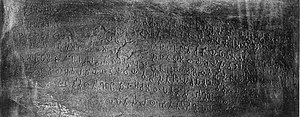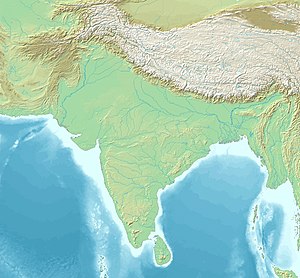| Minor Rock Edicts of Ashoka | |
|---|---|
 Minor rock edict of Sasaram. | |
| Material | Rock, stone |
| Created | 3rd century BCE |
| Discovered | 1893 |
| Present location | India |
| Part of a series on the |
| Edicts of Ashoka |
|---|
The Minor Rock Edicts of Ashoka (r. 269–233 BCE)[1] are rock inscriptions which form the earliest part of the Edicts of Ashoka, and predate Ashoka's Major Rock Edicts. These are the first edicts in the Indian language of Emperor Ashoka, written in the Brahmi script in the 11th year of his reign. They follow chronologically the Kandahar Bilingual Rock Inscription, in Greek and in Aramaic, written in the 10th year of his reign (260 BCE),[2][3] which is the first known inscription of Ashoka.[4]
There are several slight variations in the content of these edicts, depending on location, but a common designation is usually used, with Minor Rock Edict N°1 (MRE1)[5] and a Minor Rock Edict N°2 (MRE2), which does not appear alone but always in combination with Edict N°1), the different versions being generally aggregated in most translations. There is also a minor edict No.3, discovered in Bairat, for the Buddhist clergy.[6]
The inscriptions of Ashoka in Greek or Aramaic are sometimes also categorized as "Minor Rock Edicts".
The Minor Pillar Edicts of Ashoka refer to five separate Edicts inscribed on columns, the Pillars of Ashoka. These edicts are preceded chronologically by the Minor Rock Edicts and may have been made in parallel with the Major Rock Edicts.
- ^ Phuoc 2009, p.30
- ^ India: An Archaeological History: Palaeolithic Beginnings to Early ... by Dilip K. Chakrabarty p. 395
- ^ Inscriptions Of Asoka, E.Hultzsch, 1925
- ^ Valeri P. Yailenko Les maximes delphiques d'Aï Khanoum et la formation de la doctrine du dharma d'Asoka Dialogues d'histoire ancienne vol.16 n°1, 1990, p.243
- ^ Minor Rock Edict 1
- ^ Inscriptions of Asoka by DC Sircar p.32-22

